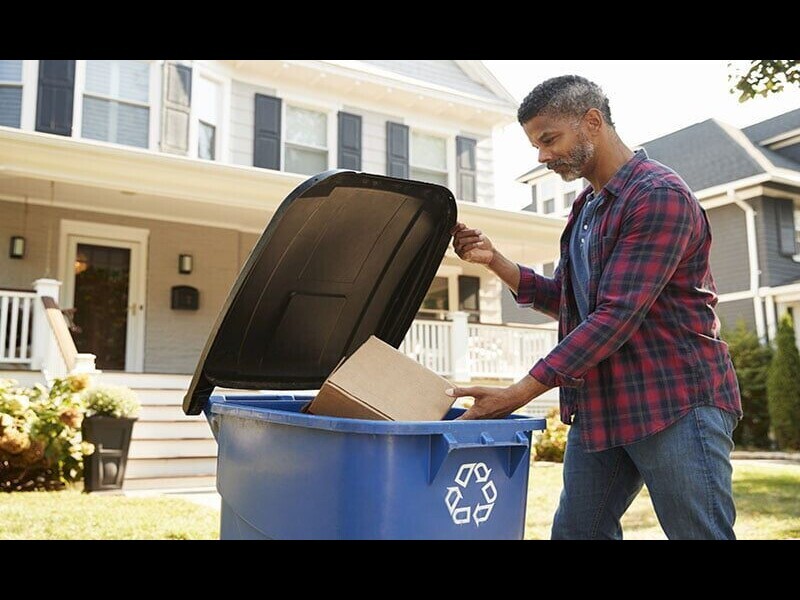Nov 18, 2020 - 10 min
4 Must-Have Formats for Sustainable Packaging

Sustainable packaging demands have increased in recent years. Several companies have committed to switching to sustainable packaging within the next decade, and studies show that consumers gravitate toward green packaging options. To keep up with rising demands, manufacturers should stay-in-the-know about sustainable packaging options for their applications. Read on to learn about four packaging formats that promote sustainability in the packaging industry and how adhesives can help you manufacture them.
Format #1: Linerless Labels
Your path to sustainable packaging may begin with switching your traditional, linered label solutions with a linerless option. Linerless labels do not require a liner to be removed before they can be adhered. They can also be designed for variable print lengths and can be cut for the exact label length needed.
By omitting a release liner, linerless labels promote sustainability in several different ways:
- Lessened waste: Compared to traditional labels, linerless options produce less waste during production, because no liner is left behind after the label is applied.
- Decreased energy use: Since more labels can fit on one roll, linerless labels require fewer roll changes in production, decreasing downtime and energy usage.
- Reduced product mass: Without release liners,more labels can fit on one pallet. This reduces freight costs and saves warehouse space, which can reduce your company’s carbon footprint.
Bostik’s range of label adhesives can help you easily integrate linerless labels into your packaging. Our adhesives bond to several substrates, including recyclable materials, enabling you to easily add additional sustainable materials into your production.

Format #2: Compostable Packaging
While biodegradable packaging is a popular option, it’s important to consider how compostable packaging can be more advantageous. This is because biodegradable packaging decomposes without a set timeframe. A product can be classified as biodegradable even if it takes hundreds of years to decompose.
Compostable packaging, however, completely decomposes in a given timeframe once discarded without leaving behind harmful residue or chemicals. This type of packaging can be achieved when all components of a package are certified to be 100% compostable by the Biodegradable Products Institute (BPI).
Compostable packaging offers many sustainable advantages, such as:
- Increased disposal: Since all the elements are compatible, compostable packaging makes easy disposal. The user will not have to discard the package components in separate streams to achieve full decomposition.
- Reduced landfill waste: Packaging makes up nearly 30% of all landfill waste. Compostable packaging reduces waste in landfills, helping to minimize greenhouse gases.
- Enhanced plant growth: As compostable packaging breaks down, it can also help stimulate plant growth.
Until recently, adhesives posed a barrier to creating BPI-certified, compostable packaging. However, Thermogrip® 43298 is the first-ever BPI-certified hot melt adhesive on the market. This product enables you to incorporate 100% compostable, BPI-certified packaging into your production, because all the package components are compatible, including the adhesive.
Format #3: Resealable Packaging
Resealable packaging enables one package to be used multiple times until its contents are finished. This eliminates need for secondary packaging. Resealable packaging can come in various forms, including peel-and-reseal or zip closures.
Resealable packaging is a sustainable packaging format for a few reasons:
- Reduced landfill waste: Resealable packaging extends product freshness by protecting contents from air, moisture and contaminants. Therefore, less food waste ends up in landfills.
- Reduces material usage: When using compostable packaging, consumers will not need to transfer the contents of a package into another container after opening. This reduces packaging material use.
Our innovative, reseal packaging adhesives enable you to easily create resealable packaging. These adhesives offer several benefits to you, including improved production line speeds and mitigating production steps. Further, our adhesives can help reduce material use in some applications, lowering your company’s carbon footprint.
Format #4: Anti-fog Lidding
Anti-fog lidding helps improve package transparency by reducing fog formation. It alters water droplets formed by condensation into a thin, uniform, transparent film. This enhances package visibility and extends food quality.
Similar to resealable packaging, this packaging format helps extend product shelf life, which creates sustainable advantages, such as:
- Extended product freshness: Moisture can increase the rate at which food decomposes. By mitigating the amount of moisture in the package, anti-fog lidding can slow the decomposition and increase food’s longevity. Less food waste is added to landfills as a result.
Our anti-fog heat seal technology can help you not only create anti-fog lidding to extend product freshness, but also further your sustainability by using fewer materials. This is because our unmatched, two-in-one products can achieve both anti-fog and heat seal capabilities in one solution. Polyester-based, they enable simplified recyclability, because the anti-fog heat seal coatings are compatible with polyester tray stocks. This allows the package to be recycled in one stream.
Like Bostik, Arkema, our parent company, also cares about formulating solutions that reduce our environmental footprint and improve sustainability. Arkema has outlined strategic goals to limit emissions, reduce energy, water and non-renewable materials consumption by 2030. Some of these initiatives include optimizing consumption of resources and evaluating the environmental impact of our products. Bostik and Arkema work together to address all aspects of sustainability, even beyond packaging. Contact a Bostik representative to learn more about how Bostik and Arkema work together to further your sustainability journey.
Check out this other relevant content:
Solutions for Sustainable Packaging
